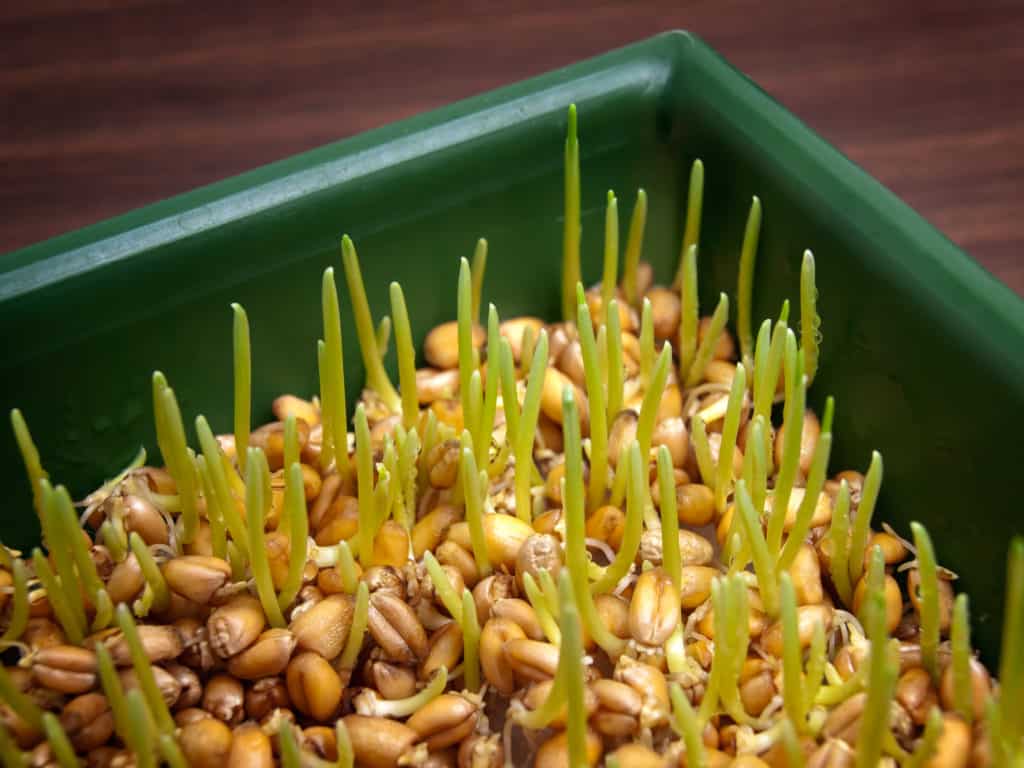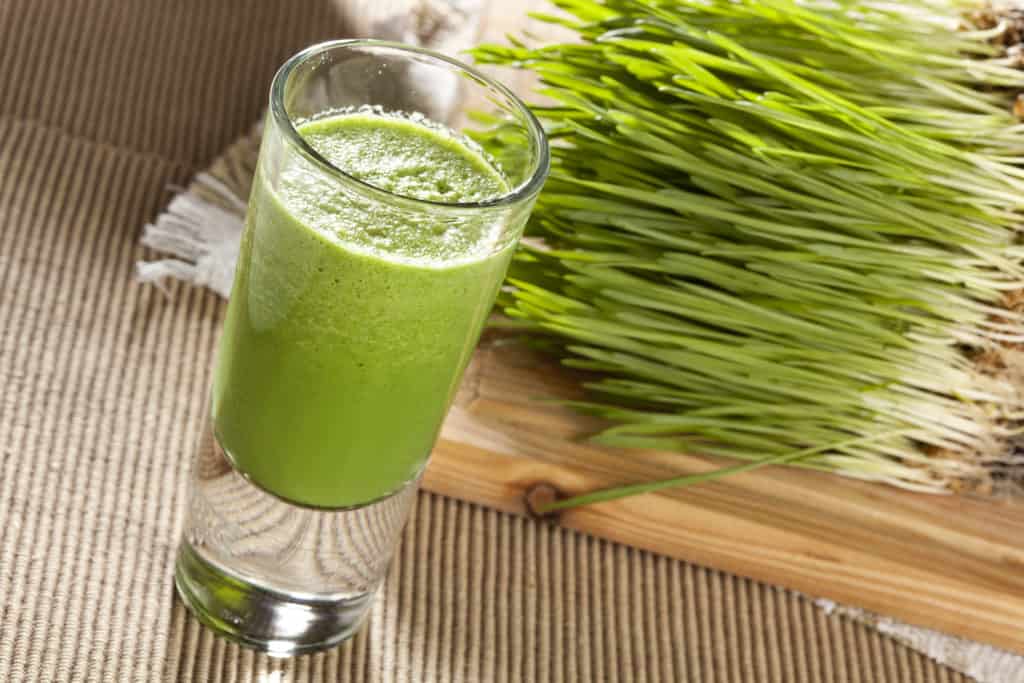If you’re looking for an easy way to get more vitamins and minerals into your and your family’s diet, wheatgrass is a good option.
You can grow your own wheatgrass at home pretty easily, so let’s talk about how to do that also.
The Many Benefits of Wheatgrass
Most people are familiar with wheatgrass as the green powder that is often added to healthy smoothies.
But what exactly is wheatgrass, and what are its health benefits?
Wheatgrass is a source of vitamins, minerals, and other healthful substances, including potassium, vitamins A, B6, C, E, and K.
Wheatgrass is a type of grass that is closely related to wheat. It is a rich source of vitamins, minerals, and other healthful substances, including potassium, vitamins A, B6, C, E, and K.
Wheatgrass also contains chlorophyll, a pigment that has powerful detoxifying and anti-inflammatory properties.
Studies have shown that wheatgrass can help to boost the immune system, improve digestion, and fight inflammation.
Wheatgrass is a good source of dietary fiber.
Everyone knows that fiber is important for staying regular, but did you know that fiber is also an essential part of a healthy diet?
Fiber helps to keep you feeling full after eating, and it can also help to lower cholesterol levels and regulate blood sugar levels.
Wheatgrass is an excellent source of dietary fiber, with nearly four grams of fiber in just one ounce. Wheatgrass is also a good source of vitamins A, C, and E, as well as calcium and iron.
Wheatgrass helps improve energy levels.
While there are plenty of ways to get an energy boost – like coffee or energy drinks – not all of them are healthy.
That’s where wheatgrass comes in. Unlike some other options, wheatgrass is low in calories and contains no caffeine or other stimulants.
Instead, it’s packed with vitamins, minerals, and antioxidants that help to support overall health.
Wheatgrass can be enjoyed in juice form or as a powder that can be added to smoothies or other beverages.
And best of all, it provides a slow and steady release of energy that can help you feel your best all day long.
Wheatgrass may help improve overall health.
Some people believe that wheatgrass can help improve overall health by providing the body with essential nutrients.
The high chlorophyll content in wheatgrass is often cited as one of its main health benefits.
Chlorophyll is a pigment that helps plants convert sunlight into energy.
This process is known as photosynthesis. Some people believe that consuming chlorophyll-rich foods like wheatgrass can help increase energy levels, detoxify the body, and boost immunity.
While there is no scientific evidence to support these claims, wheatgrass may be worth trying if you are looking for a way to improve your overall health.
Gear for Growing Wheatgrass at Home
 Pin
PinIf you’re interested in growing wheatgrass at home, there are a few things you’ll need to get started. Learning how to grow your own wheatgrass is surprisingly easy.
Wheatgrass seeds
These can be purchased from a gardening store locally or online. I love True Leaf Market for wheatgrass seeds because you can buy just a little or you can save money compared to other seed shops by buying in bulk.
They also sell a lot of the other items you’ll need for growing wheatgrass seeds, conveniently.
A growing container
Once you have your seeds, you’ll need a container to grow them in. A shallow tray or pot will work fine, but I recommend these 10×20 seed starting trays that are compact, easy to grow in, and easy to carry.
You can also repurpose them for starting any other kinds of seeds you work with.
Water, a small watering can, and a sturdy spray bottle
You can use a small watering can 1/4 gallon or smaller is best unless you have a large growing operation.
Grab a spray bottle that will hold up to a lot of use rather than a flimsier one that will break after a couple of grow sessions.
Growing medium
You’ve got a few options when it comes to growing wheatgrass.
- Soil is easy to find and inexpensive, and it provides nutrients that wheatgrass needs to grow. However, soil can also be difficult to clean, and it may harbor harmful bacteria.
- Coconut coir is a popular growing medium for wheatgrass. It’s made from the fiber of coconut husks, and it’s an environmentally friendly alternative to peat moss. Coconut coir is also relatively inexpensive and easy to find at a gardening center.
- Jute growing mats are a low-mess solution to growing wheatgrass. They also help to aerate the soil and prevent compaction, which can lead to unhealthy root systems. They make it easier to harvest and clean your wheatgrass once it’s ready, but they do come at a more premium price. They’re fully compostable when you’re finished with them, so that’s awesome.
Ultimately, the best growing medium for wheatgrass will depend on your individual needs and preferences.
Planting Wheatgrass Seeds
- To start your wheatgrass, soak them for 8-12 hours or overnight, but not much longer than that. Strain when they’re done soaking.
- Add your growing medium to your seed starting tray and pat it down so that the surface is even.
- Sprinkle the seeds on top of the potting mix and lightly mist them with water.
- Place the container in a sunny spot and keep the soil moist. In a day or two, you should see sprouts starting.
- It’s okay if the sprouts are yellow at first – once they get some light soaked up, they’ll green-up.
- Once it reaches about 6 inches tall, you can cut it and enjoy it in salads, smoothies, or juiced drinks.
Tips for Growing Wheatgrass at Home Successfully
Soak the seeds for 8-12 hours before planting
Before planting wheatgrass, it is important to soak the seeds in water for 8-12 hours. This allows the seeds to absorb enough moisture so that they can begin germination. Once the seeds have soaked, drain off any excess water and plant them according to the package directions.
You can harvest wheatgrass multiple times using the cut and come again method
Once your wheatgrass has reached about 6 inches tall, you can harvest it. To encourage continuous growth, only cut the grass about 2 inches above the soil surface. The grass will quickly regrow and be ready to harvest again in a few weeks.
Tips for mold prevention while growing wheatgrass
Crops like wheatgrass and microgreens are prone to mold which is why it’s important to harvest them quickly once they are the correct height.
There are a few things you can do to prevent mold from growing on your wheatgrass or growing medium.
Put a tablespoon of azomite powder into your watering can. Mix well. Spray or mist onto wheatgrass. If this doesn’t eliminate the mold, after the grass is ready, cut what you need, put it into a large strainer, power rinse, and then juice.
You can also try using liquid grapefruit seed extract which is sold online. I prefer the azomite because azomite has many more uses in the garden and can be used to improve the soil.
10 Creative Ways to Use Wheatgrass in your Cooking
Wheatgrass can be added to soups and stews for an extra dose of nutrients, or used as a garnish for salads and other dishes.
It can also be blended into smoothies or used to make healthy pesto. If you plan to juice wheatgrass, you’ll want a wheatgrass juicer to do this for you in a way that removes the pulp of the plant. This manual wheatgrass juicer does the trick without being super spendy.
If you’re looking for a new way to incorporate wheatgrass into your diet, get creative in the kitchen and see what dishes you can come up with. You may be surprised at how delicious wheatgrass can be.
Here are a few great ideas to get you started.
- Superfood Pesto
- Gingery Green Protein Smoothie Bowl
- Vegan Wheatgrass Pineapple Ice Cream
- Wheatgrass Latte
- Avocado Potato Salad
- Chilled Tarragon Zucchini Soup
- Naturally Green Shamrock Shake
- Edamame Hummus
- Wheatgrass Juice Shot
- Green Goddess Smoothie
Wheatgrass FAQs
Answers to some common questions about wheatgrass, including how to grow it and what the benefits are.
What is wheatgrass?
Wheatgrass is a type of grass that is closely related to wheat. It is a rich source of vitamins, minerals, and other healthful substances, including potassium, vitamins A, B6, C, E, and K.
What are the benefits of wheatgrass?
Wheatgrass is said to offer a wide range of health benefits, including boosting the immune system, improving digestion, and fighting inflammation.
Is wheatgrass healthier than other types of greens?
There is no scientific evidence to support this claim. However, wheatgrass does contain a higher concentration of vitamins and minerals than most other vegetables.
What are the best ways to use wheatgrass?
Wheatgrass can be enjoyed in juice form or as a powder that can be added to smoothies or other beverages. It can also be used in recipes for smoothies, juices, and salads.
Growing wheatgrass vs. growing microgreens
Growing wheatgrass and microgreens is a similar process.
Is wheatgrass healthier than microgreens?
There is no clear answer as to whether wheatgrass is more or less healthy than other types of greens. However, wheatgrass does offer a unique nutrient profile that may be beneficial for certain people.
What does wheatgrass taste like?
Wheatgrass has a grassy, slightly sweet taste. It is often described as being similar to the taste of green tea.
How can I make wheatgrass taste better?
If you are not a fan of the taste of wheatgrass, you can try adding it to smoothies or juices. You can also add flavorings like honey, lemon juice, or mint leaves to make it more palatable.
Is wheatgrass safe around pets?
Yes, wheatgrass is safe for pets. However, it is important to make sure that your pet does not eat too much of it, as it can cause digestive issues.
How do I store wheatgrass?
Wheatgrass can be stored in the refrigerator for up to a week. It is also possible to freeze it or dehydrated it and add it to a greens powder for longer-term storage.
Is wheatgrass safe for kids?
Yes, wheatgrass is safe for kids outside of any allergies. However, it is important to make sure that your child does not eat too much of it, as it may cause digestive issues if too much is eaten.
Are wheatgrass seeds non-GMO?
Most seed sellers aren’t allowed to sell GMO seeds to the public. They are typically available for farmers only.
The wheatgrass seeds you’ll find publically available for purchase online will usually not ever knowingly be GMO seeds.

